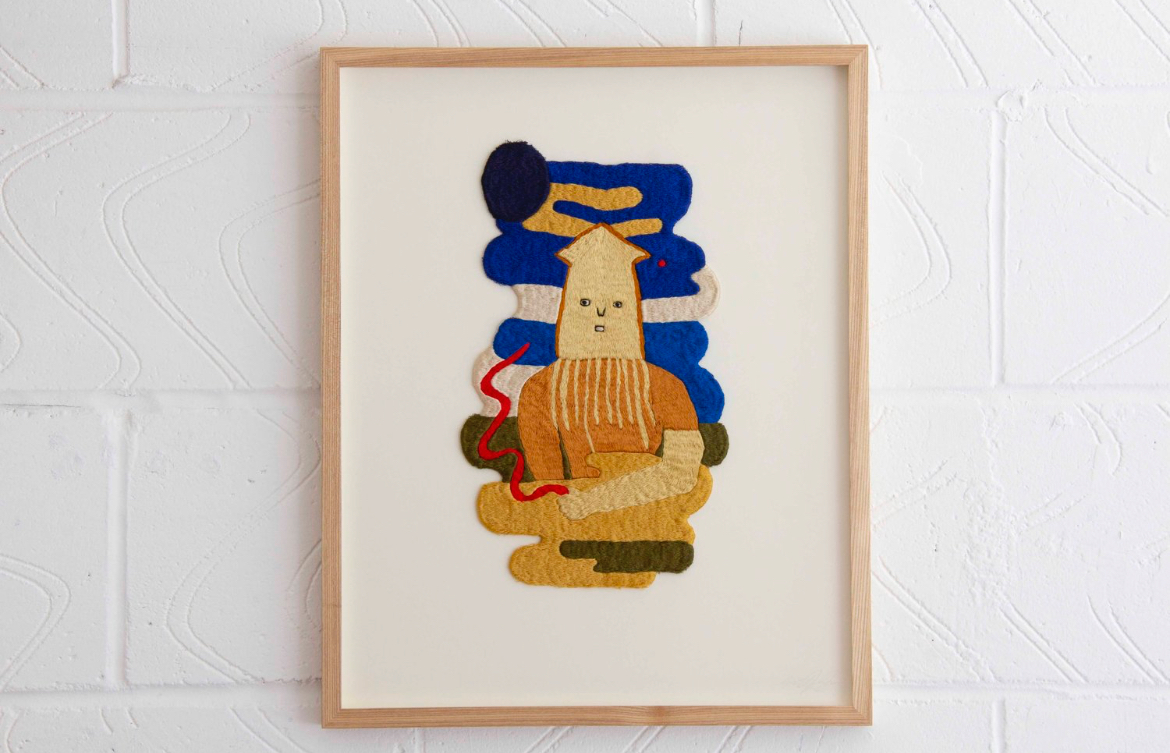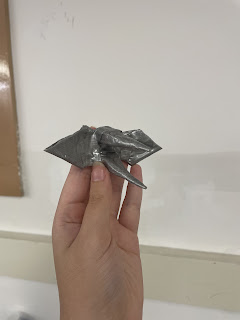The Elepecker
Plastic, teal wool, green wool
5” x 5” x 2”
Full, Angle 1
Full, Angle 2
Artist’s Statement
This work represents a fond memory of creating origami creatures called “elepeckers” with my childhood best friend. He always loved origami. He would create many different creatures and objects using the bright red construction paper that his parents brought home one day. My favorites were the elepeckers, which were really just half finished origami cranes that were turned sideways. We would play with them at recess, making them eat berries off trees. The red, 3D printed plastic body is intended to capture the red paper that we would use to construct these creatures. Balance, symmetry, line and geometric form mimic the harsh creases of the paper. The felted berry within the elepecker’s mouth balances out the rigid body, adding a softer texture to the piece and making it appear more lighthearted. Emphasis on this berry makes the playful elements of the piece stand out, giving it a more positive aura.
In-process Image 1
In-process Image 2
Inspiration #1
 Azikiwe Mohammed
Azikiwe Mohammed
Inspiration #2
Inspiration #3
Joseph Weiner (my close friend and the original creator of the elepecker)
On Longing
“The body is the primary mode of perceiving scale.”
In this picture, you can see fifteen year old me standing next to my dad. At this point in my life, I had been completely consumed by an eating disorder. Not only does my dad dwarf me in comparison, but so does my denim jacket, which I would always wear. I felt large by appearing small. I later lost this jacket, which, in my eyes, marked the end of ceaseless tumult and starvation. I had moved on. Looking at this picture and seeing that jacket allows me to happily reminisce on how I overcame such a profound struggle.
“The souvenir speaks to a context of origin through a language of longing, for it is not an object arising out of need or use value.”
These pictures are of me and my boyfriend replicating a scene from one of our favorite movies. They were taken at a photo booth inside the bowling alley where our close friends celebrated their move from Florida to Alabama. Not only do I miss those friends dearly, I miss my boyfriend while I’m away at college. These pictures hang on my wall, reminding me of those that I care about most.
The souvenir reduces the public, the monumental, and the three-dimensional into miniature — that which can be enveloped by the body.”
Here, I am standing at one of the earliest Black Lives Matter protests, outside Derek Chauvin’s Florida home. I hand painted the sign myself, and toted it around in order to support the cause. I attempted to capture a level of grittiness and pain that most protest signs are unable to articulate, and yet, I still ended up reducing a grand scaled issue into a smaller message that viewers could take in. In no way could I ever encapsulate the struggles that countless endure into one art piece. Still, I tried.
“To have a souvenir of the exotic is to possess both a specimen and a trophy.”
This is a picture of a taxidermy, albino raccoon, inside what was once Wolf’s Museum. I’m an oddity/taxidermy collector and raccoon enthusiast, so seeing this put a smile on my face. It’s a shame that Wolf’s burned down. Serving as both a scientific specimen and a work of art, I feel that this piece clearly represents the concept cited above.
“The place of origin must remain unavailable in order for desire to be generated.”
This photo is of me and my parents in our old home. It represents my longing for the youth, environment, and stability that I can no longer return to. Things are much harder now, and I’d give anything to go back to this time.



.jpeg)



.jpeg)
.jpeg)













_Mon_seul_de%CC%81sir_(La_Dame_a%CC%80_la_licorne)_-_Muse%CC%81e_de_Cluny_Paris.jpg)


























